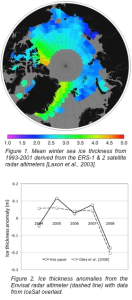Determining sea ice thickness from space-borne radar altimetry
Rachel Tilling, Andy Ridout, Andy Shepherd, Seymour Laxon, Katharine Giles
Knowledge of sea ice thickness is critical to understanding current changes in Arctic sea ice cover, for validating models and to help improve predictions in the future. Historically large-scale information of sea ice thickness come from measurements of ice draft by military submarines. These data have revealed substantial decreases in ice thickness over the last 30 years but the area over which the data are gathered is limited and the measurements are made only at certain times of year.
Satellite altimeters can make precise measurements of sea ice freeboard by combining elevation measurements of leads and floes in areas of sea ice. The freeboard is then converted to thickness by assuming the ice is in hydrostatic equilibrium. The first space-borne estimates of sea ice thickness, from measurements of sea ice freeboard, were made by CPOM using data from the European Space Agencies ERS-1 and ERS-2 satellites (Figure 1). The data showed that ice thickness was highly variable from year to year and that changes were closely linked to the length of the summer melt season.
A later time-series, generated using ESA’s Envisat mission, revealed a large drop in ice thickness following the record 2007 minimum ice extent (Figure 2; [Giles et al., 2008]) a result later confirmed by data from NASA’s IceSat laser altimeter mission [Kwok et al., 2009].
Efforts are now underway to generate, calibrate and validate the first estimates of ice thickness from ESA’s CryoSat radar altimeter. The first dedicated polar altimeter mission for which CPOM provide the scientific leadership.
The CPOM Cryosat-2 sea ice thickness data are avaliable here.
References:
Giles, K. A., et al. (2008), Circumpolar thinning of Arctic sea ice following the 2007 record ice extent minimum, Geophys Res Lett, 35(22), doi:10.1029/2008GL035710,.
Kwok, R., et al. (2009), Thinning and volume loss of the Arctic Ocean sea ice cover: 2003-2008, J. Geophys. Res.-Oceans, 114, doi:10.1029/2009JC005312.
Laxon, S., et al. (2003), High interannual variability of sea ice thickness in the Arctic region, Nature, 425(6961), 947-950.

